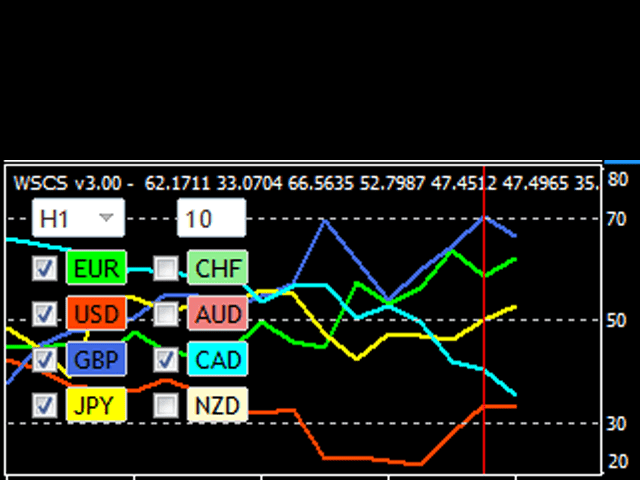The indicator shows the relative strength of the eight major currencies, comparing each of them with the others. The results are displayed in an easy-to-understand graphical form.
Currencies: EUR, USD, GBP, JPY, CHF, AUD, CAD, and NZD.
Have you ever wondered which currency moves the pair?
For example, if the EURUSD goes up, does it mean that the EUR is strengthening or that the USD is weakening?
This small indicator will quickly show you what’s going on!
- “Number of Bars”: the number of bars to calculate and display. By default, 300.
- “Pairs Prefix”: If the pair has a prefix, enter it here. For example, x. EURUSD –> enter ” x.”
- “Pairs Suffix”: If the pair has a suffix, enter it here. For example, EURUSD.m –> enter “.m”
The indicator can be applied to any instrument.
The only requirement: all possible combinations that can form the specified eight pairs must be in the “Market Overview” window.
Right-click in the Market Overview window and select Show All Symbols.
If necessary, the indicator will load the missing history.
You can track this process on the “Experts”tab of the terminal.
If there is not enough history for some pairs to calculate (or the pair is not available), the corresponding pairs will be disabled! (see screenshots)
[spoiler title=”Read More…”]
If there is not enough history for some pairs to calculate (or the pair is not available), the corresponding pairs will be disabled! (see screenshots)
Required pairs:
- EURUSD, EURJPY, EURGBP, EURCHF, EURAUD, EURCAD, EURNZD
- USDJPY, GBPUSD, AUDUSD, NZDUSD, USDCHF, USDCAD
- GBPAUD, GBPCHF, GBPCAD, GBPJPY, GBPNZD
- AUDJPY, CHFJPY, CADJPY, NZDJPY
- AUDCHF, CADCHF, NZDCHF
- AUDNZD, AUDCAD
- NZDCAD
And finally, the pair on which you will run the indicator.
More detailed information is provided in the screenshots.
I am ready to answer your questions.
Good luck!
[/spoiler]





